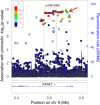Recent advances in understanding the genetic architecture of type 2 diabetes
- PMID: 26160912
- PMCID: PMC4572004
- DOI: 10.1093/hmg/ddv264
Recent advances in understanding the genetic architecture of type 2 diabetes
Abstract
Genome-wide association (GWAS) and sequencing studies are providing new insights into the genetic basis of type 2 diabetes (T2D) and the inter-individual variation in glycemic traits, including levels of glucose, insulin, proinsulin and hemoglobin A1c (HbA1c). At the end of 2011, established loci (P < 5 × 10(-8)) totaled 55 for T2D and 32 for glycemic traits. Since then, most new loci have been detected by analyzing common [minor allele frequency (MAF)>0.05] variants in increasingly large sample sizes from populations around the world, and in trans-ancestry studies that successfully combine data from diverse populations. Most recently, advances in sequencing have led to the discovery of four loci for T2D or glycemic traits based on low-frequency (0.005 < MAF ≤ 0.05) variants, and additional low-frequency, potentially functional variants have been identified at GWAS loci. Established published loci now total ∼88 for T2D and 83 for one or more glycemic traits, and many additional loci likely remain to be discovered. Future studies will build on these successes by identifying additional loci and by determining the pathogenic effects of the underlying variants and genes.
© The Author 2015. Published by Oxford University Press. All rights reserved. For Permissions, please email: journals.permissions@oup.com.
Figures

References
-
- Danaei G., Finucane M.M., Lu Y., Singh G.M., Cowan M.J., Paciorek C.J., Lin J.K., Farzadfar F., Khang Y.H., Stevens G.A. et al. (2011) National, regional, and global trends in fasting plasma glucose and diabetes prevalence since 1980: systematic analysis of health examination surveys and epidemiological studies with 370 country-years and 2.7 million participants. Lancet, 378, 31–40. - PubMed
-
- NCEP Expert Panel. (2002) Third Report of the National Cholesterol Education Program (NCEP) Expert Panel on Detection, Evaluation, and Treatment of High Blood Cholesterol in Adults (Adult Treatment Panel III) final report. Circulation, 106, 3143–3421. - PubMed
-
- Poulsen P., Kyvik K.O., Vaag A., Beck-Nielsen H. (1999) Heritability of type II (non-insulin-dependent) diabetes mellitus and abnormal glucose tolerance—a population-based twin study. Diabetologia, 42, 139–145. - PubMed
Publication types
MeSH terms
Substances
Grants and funding
- R01 DK093757/DK/NIDDK NIH HHS/United States
- DK093757/DK/NIDDK NIH HHS/United States
- R56 DK062370/DK/NIDDK NIH HHS/United States
- R01 DK098032/DK/NIDDK NIH HHS/United States
- R01 DK072193/DK/NIDDK NIH HHS/United States
- R01 DK062370/DK/NIDDK NIH HHS/United States
- DK072193/DK/NIDDK NIH HHS/United States
- U01 DK085584/DK/NIDDK NIH HHS/United States
- DK085584/DK/NIDDK NIH HHS/United States
- DK062370/DK/NIDDK NIH HHS/United States
- P30 DK020572/DK/NIDDK NIH HHS/United States
- DK105561/DK/NIDDK NIH HHS/United States
- U01 DK105561/DK/NIDDK NIH HHS/United States
- DK098032/DK/NIDDK NIH HHS/United States
- U01 DK062370/DK/NIDDK NIH HHS/United States
LinkOut - more resources
Full Text Sources
Other Literature Sources
Medical

